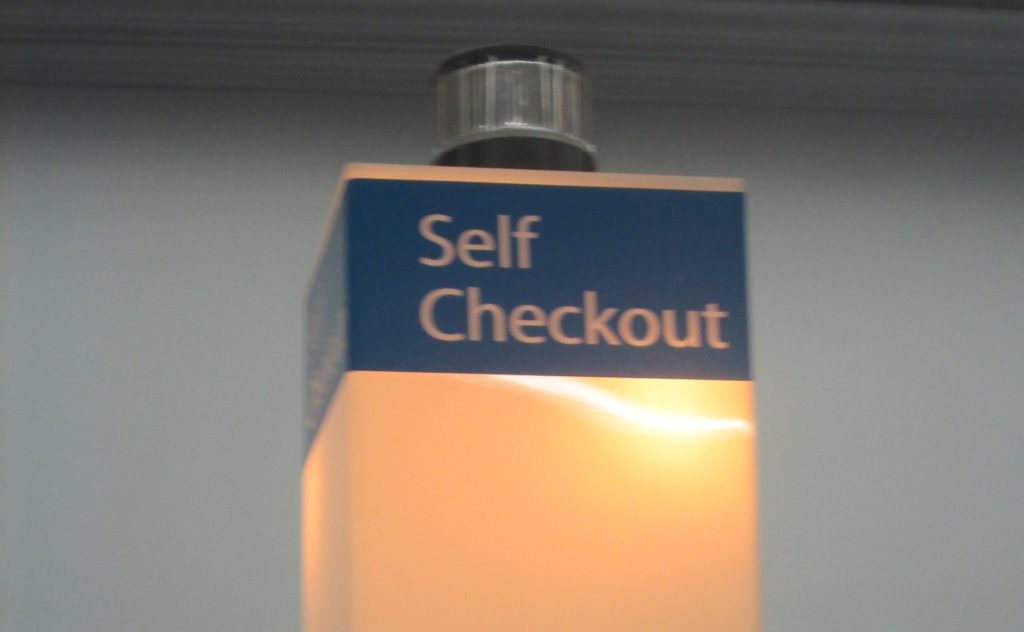
The New England grocery chain Big Y made a big move several years ago, when it very publicly became one of the first major chains to sour on self-checkout machines, and yanked them out of all of its stores. The machines were confusing and frustrating to customers, slowed down the checkout process, caused difficulty when using coupons – and made it too easy for some customers to steal stuff, the company said.
But years after Big Y gave self-checkouts the big heave-ho, it’s reversing course. The retailer recently unveiled a newly-remodeled store that prominently features self-checkout machines. And other remodeled stores are getting the machines back, too, “in response to changing customer demand,” Big Y says.
Meanwhile, self-checkout machines are still confusing and frustrating to customers, still slow down the checkout process, still cause difficulty when using coupons – and still make it easy for some customers to steal stuff.
So then why are they apparently making a comeback? Many more retailers in recent years have added self-checkouts than removed them – even though a new study says self-checkouts are as frustrating to customers as ever.
“While retailers and other service providers are increasingly introducing self-service checkouts into stores, these technologies do not have universal appeal for consumers,” write the authors of a new study to be published in an upcoming edition of the Journal of Retailing and Consumer Services. In “Exploring the Adoption of Self-Service Checkouts and the Associated Social Obligations of Shopping Practices”, the researchers interviewed self-checkout users and found that “unwilling customers feel a sense of social obligation to use self-service checkouts”.
In other words, self-checkouts are here, they’re not going anywhere, everyone else is using them, so you might as well get used to them.
The study reveals “four key contradictions” that make self-checkouts both helpful and unhelpful, efficient and inefficient, liked and loathed.
The first is that self-checkouts both solve problems, and create new ones. Some shoppers interviewed for the study said they like that self-checkouts allow them to get out of the store faster, and allow them to buy personal products without embarrassment. One shopper even said she likes “avoiding the human interaction sometimes. I don’t really like small talk.”
But those same shoppers admitted that self-checkouts can be awfully aggravating. “Every time I use it, there are just so many issues created from having that weight sensor and it’s just really annoying,” one shopper said. Another dislikes the loud computerized voice that scolds you when you do something wrong. In cases like that, the study’s authors write, using self-checkout “can paradoxically turn a private transaction into a very unpleasant public experience”.
Next is the “efficiency/inefficiency paradox”. Satisfied customers said self-checkout is “all very streamlined and effective”, with one saying “I like the speed they allow. I can get through the checkouts way faster.”
But certain aspects of self-checkout turn what should be an efficient process, into an especially inefficient one. “You can’t even use the coupons, and gift cards, it’s just ridiculous,” one shopper complained. “Sometimes the sensors are messed up which results in the machine telling you to do something you have already done, like put something in the bagging area and you have… or swiping your card and you already have,” another shopper said. “The assistant is never there to assist when needed… which defeats the purpose of an efficient, quick checkout self-service,” said a third.
The third contradiction has to do with making shoppers feel empowered, and also helpless. “Shoppers can very quickly move from feeling competent to inept” while using self-checkout, the study’s authors write. While some claim to have mastered self-checkout technology, other shoppers said it can leave them feeling incompetent. “When the voice pops up telling me to remove something that is not there, making me feel like a complete idiot, [I] wish that I had just gone to the other checkouts,” one shopper admitted.
Lastly, there’s the paradox that self-checkouts “both facilitate control and create chaos”. Satisfied shoppers said they like controlling the pace of the checkout process and packing their bags the way they like. But others said self-checkouts make them want to throw up their hands and give up. “There is always a problem… it just seems disorganized,” one shopper complained. “People are behind you… you know that they’re wanting you to hurry up,” another said. And when there are lines for the self-checkout machines, “everyone is floundering about not knowing who is next,” another customer said. With self-checkouts, “grocery shopping can be transformed from the habitual and familiar to the chaotic and bewildering,” the researchers write.
For every store that eliminates its self-checkout machines, though, another store will add them – because self-checkouts are terrible, but also great. That’s the gist of the study, which concludes that “while the technology provides control and efficiencies, particularly time saving, it can simultaneously trigger feelings of loss of control, time wasting and incompetence.”
In Big Y’s case, it took out self-checkout machines due to customer complaints, then brought them back due to customer demand. So you could say its position is something of a paradox – just like, it seems, self-checkouts themselves.











Given the choice, I opt for self-checkout every time. I guess I’m the minority?
Of course the real advantage to STORES with self-checkout (not covered at all in above article) is that it can dramatically lower personnel costs (as multiple self-checkout machines replace a number of cashiers).
Personally, I like self-checkout when the store does it right. Here in Denver, CO, for example, the Safeway stores with self-checkout allow the customer to scan their own coupons, and each transaction is announced, along with its discounts, and digital coupons applied, etc. I can pace speed of checkout so that I can tell exactly what is going on (something that is impossible with the speed human cashiers insist on). King Soopers self-checkout, however, makes you call for a human cashier intervention in order to use paper coupons which is annoying and slows everything down.